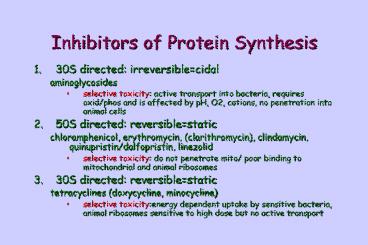Inhibitors of Protein Synthesis - PowerPoint PPT Presentation
1 / 24
Title:
Inhibitors of Protein Synthesis
Description:
Inhibitors of Protein Synthesis – PowerPoint PPT presentation
Number of Views:3123
Avg rating:3.0/5.0
Title: Inhibitors of Protein Synthesis
1
Inhibitors of Protein Synthesis
- 30S directed irreversiblecidal
- aminoglycosides
- selective toxicity active transport into
bacteria, requires oxid/phos and is affected by
pH, O2, cations, no penetration into animal cells - 50S directed reversiblestatic
- chloramphenicol, erythromycin, (clarithromycin),
clindamycin, quinupristin/dalfopristin, linezolid - selective toxicity do not penetrate mito/ poor
binding to mitochondrial and animal ribosomes - 30S directed reversiblestatic
- tetracyclines (doxycycline, minocycline)
- selective toxicityenergy dependent uptake by
sensitive bacteria, animal ribosomes sensitive to
high dose but no active transport
2
Folic Acid Pathway Inhibitors
- sulfonamides, trimethoprim
- selective toxicity
- sulfonamides animal cells do not make folate,
we absorb it from the environment - trimethoprim has much higher affinity for the
bacterial DHFR than the mammalian DHFR
3
(No Transcript)
4
Pathway of tetrahydro- folate cofactor
synthesis and role in DNA, RNA, and protein
synthesis
5
Folic Acid
6
thymidylate synthetase
DHFR
7
(No Transcript)
8
Synergistic combinations of Trimethoprim
Sulfamethoxazole (Bactrim, Septra)
- Staph sensitivity
- Sulfamethoxazole MIC 3 ug/ml
- Trimethoprim MIC 1 ug/ml
- combo MIC 0.3 Sulf 0.015 Trim
- 201 ratio most effective
- Advantages
- more likely to be cidal
- broader spectrum
- decreased resistance
- lower doses lower toxicity
9
Other mechanisms
- Membrane disrupters
- Daptomycin
- lipopeptide that binds bacterial membranes
- causes ion leakage and membrane depolarization
- leads to cell death (cidal)
10
Daptomycin action
- active against gram including methicillin
resistant Staph A (MRSA) and vancomycin resistant
enterococcus (VRE) - alternative to vancomycin for MRSA (especially
important as vancomycin resistant MRSA emerges - other alternatives linezolid,
quinupristin/dalfopristin,
11
Other mechanisms
- RNA synthesis inhibitors
- rifampin--binds bacterial RNA Polymerase and
inhibits - selective toxicity little binding to human RNA
polymerase - DNA gyrase/topoisomerase inhibitors
- prototype nalidixic acid
- fluoroquinolones
- ciprofloxacin, norfloxacin broad spectrum, low
toxicity - newer derivatives trovafloxacin, moxifloxacin,
levofloxacin have expanded spectrum, longer half
life, high oral bioavailability
12
Function of DNA gyrase and topoisomerase IV in
replication and transcription
13
Mechanism of action of ciprofloxacin and
other DNA gyrase/topoisomerase IV inhibitors
14
Quinolones
15
Metronidazole--mechanism of action
- Anaerobic organisms contain ferredoxins that can
activate metronidazole to form a reactive nitro
radical anion that kills by targeting DNA/other
biomolecules - Treatment examples
- Giardiasis (protozoal infection)
- also used to treat Clostridium difficile
16
Risk of Giardia in the mountains?
up to 35 of children in daycare test positive
for Giardia in stool samples! most asymptomatic
17
Oral Absorption of Antibiotics
Good sulfonamides chloramphenicol clindamyc
in trimethoprim isoniazid, pyrazinamide ciprofl
oxacin doxycycline cycloserine metronidazole l
inezolid Bad or variable penicillins (some
are, many arent) cephalosporins (few are, most
are not) erythromycin (estolate
conjugate) (clarithromycin is better)
Ugly aminoglycosides gentamicin tobramycin
amikacin netilmicin vancomycin quinupristin/
dalfopristin meropenem
18
Therapeutic levels in the CSF?
Good ciprofloxacin sulfonamides,
trimethoprim chloramphenicol some 3rd
generation cephalosporins (e.g. ceftriaxone,
ceftizoxime) meropenem cycloserine,
metronidazole pyrazinamide, isoniazid linezolid
OK (esp. when meninges inflamed) ampicillin,
ticarcillin vancomycin rifampin
Poor aminoglycosides tetracyclines clindamycin
erythromycin cefaclor quinupristin/dalfopristi
n (synercid)
19
Distribution of drug into human cells?
- Pathogens can enter cells
- Require intracellular phase
- Rickettsia (cytoplasm)
- Chlamydia (phagosomes)
- Can survive both intra and extracellular
environment - Mycobacteria (cytoplasm phagosomes)
- Legionella (phagosomes)
- Listeria (cytoplasm)
- Salmonella (phagosomes)
- Question Do antibiotics need to penetrate
animal cell to kill these pathogens? - probably not but it may help
20
Antibiotic metabolism and excretion
- excreted unchanged via kidney
- metabolized by liver
- metabolites excreted by kidney
- metabolites excreted thru bile
- Affected by renal/hepatic disease, developmental
state, pharmacogenetic traits, and drug/drug
interactions
21
Drug Metabolism and Excretion
Excretion by Kidney (primarily) penicillins/cepha
losporins (both kidney and liver for
some) aminoglycosides tetracyclines (except
doxycycline) sulfonamides vancomycin ciprofloxa
cin trimethoprim pyrazinamide
22
Chloramphenicol is metabolized in liver and then
excreted by kidney
23
age 1-2 days
age 1-11 years
24
Application of pharmacokinetic principles
- Bactrim 400mg sulfamethoxazole 80 mg
trimethoprim in fixed dose---does this make
sense? - what basic properties of these two drugs are
relevant? - optimal plasma ratio and concentration
- t1/2
- oral bioavailability
- volume of distribution
- drug interactions

